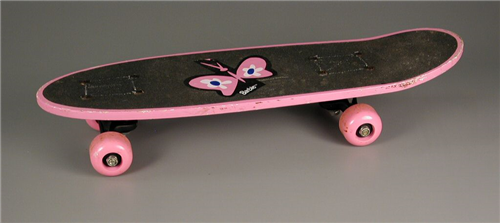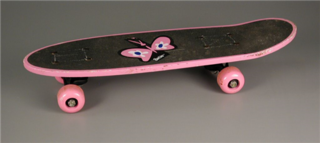Play
When Is a Toy a Toy?
Gateways to creativity.
Posted October 21, 2022 Reviewed by Hara Estroff Marano
Key points
- Toys that encourage distant attention boost creativity.
- Creativity depends upon letting go of intrusive thoughts.
Executive toys fill a category all their own: droll stress-reducers. They may double as keychain fobs, novelty items that fans and enthusiasts carry to advertise their enthusiasm for their sport—a talisman, of sorts. A golfer may hold her car keys together with a miniature golf bag. A football fan might attach a tiny Buffalo Bills helmet to his keyring to promote his hometown bona fides. And a skateboarder might own a tiny replica if the real thing.

But likely this "fingerboard" is more than an advertisement and its purposes more varied than tension reduction, and understanding its complexity opens a window into imaginative play.
So, What Is a Fingerboard?
The fingerboard is a model skateboard about four inches long that plausibly and faithfully replicates all the parts of a skateboard—the deck, the “truck,” neoprene wheels that really roll, even the cheeky graphics decoupaged onto the real-size thing. Plenty of things are small—geckos, grapes, golf balls, guavas and so on—but their size alone exerts no special fascination on us.
But fingerboards command your attention as other minuscule replicas do for their audacious accuracy in miniaturization; shrinking something is, of itself, amazing. We can say the same thing about HO gauge locomotives, origami airplanes, a tiny tableau of the Nina, the Pinta, and the Santa Maria floating in an “impossible” bottle, Old Testament verses inscribed on grains of rice, lilliputian model Maseratis ready to peel out, and other fantastic achievements. Why are we drawn to these little things? The novelist Steven Millhauser ventured that the miniature confronts us with discrepancy and distortion that is hard to look away from. “The eye,” he noted, is “irritated into attention.”
But listing the components of the fingerboard and noting its appeal won’t do to answer the question “what is a fingerboard?” Instead, what you do with the fingerboard says what it is.
Action Is Definition
For example. If the expert uses the fingerboard to demonstrate tricks for a novice learning to perform flips, ollies, grabs, slides and grinds, the fingerboard becomes an instructional tool aiming to describe in three dimensions processes that are easier visualized and embodied than put into words. Similarly, the combat instructors who trained jet-fighter pilots in dogfighting techniques at Top Gun training used mini aircraft attached to batons to demonstrate strategic maneuvers, the attacks and evasions that make up aerial battles. But it would be hard to call these instructional props toys, and it would be a mistake to call the instruction for deadly purpose play.
When Is a Toy a Toy?
On the other hand, if you use the fingerboard to imagine your own moves on a life-sized skateboard, you’re picturing the complicated sequence of fearless, gravity-defying events that make up even the most straightforward skateboard trick. In a word, you’re playing.
And when you’re at play with embodied thinking like this, the fingerboard as a gateway to the imagination becomes a toy. (I saw a similar prefiguring when my daughter, in her time as a competitive Irish dancer, would, before going on stage, practice a sequence of steps with her hands, eyes closed and deep in the zone, the music playing in her head.)
And then it follows that, yes, when you are fooling with the toy that you hold in your hand and even if you’re seriously practicing, you’re playing.
The Set and the Setting of Play
But let’s think a little more about the setting and the mindset of play. The fingerboard fits into a class of “executive toys” or office toy, or sometimes, pejoratively, a “useless machine.” But of course, these toys are not useless —just as play is not useless.
The suspended silver balls that you set clacking in a Newton’s cradle might as a tool of instruction usefully be used to demonstrate the conservation of momentum. Or it might in an even more interesting way be used to cast your mind adrift. The effect of the clacking balls is mesmerizing. Likewise, trying to solve a Rubik’s cube crowds out all other mental chatter. Then too, a loop of string wound around fingers for cat’s cradle figure tricks absorbs one’s solitary attention. On a simpler plane one can find the same mental disengagement fiddling with the toy called a “fidget spinner.” Playing with that rudimentary toy may amount merely to an act of tension-reduction or release from boredom.
But more profoundly and usefully, as with all these executive toys, distant attention while occupied with some repetitive task and thinking about nothing much while you’re not quite thinking, spurs your creativity.
Distant Attention and Letting Go
In his memoir Stop Time, the novelist Frank Conroy writes of his own experience with distant attention in his quest to master the yo-yo. “As I watched the trick unfold,” he wrote, “it was as if a ghost or a spirit was controlling the yo-yo’s movements, and that to be really good one had simply to give up one’s desire to dominate the yo-yo and instead let the ghost take over.”
To yo-yo, you need to let go.
When I hit a snag writing, some pesky sentence that has me stuck wrestling with a thought that won’t cooperate, I’ll reach for the yo-yo, an old transparent Imperial that sits on my bookshelf. Truth is, I’d never win a yo-yo contest. But. After a few throws, maybe a walk-the-dog trick or a skin-the-cat, or a swooping “around the world” takes my mind off the knotted prose, refreshingly. The simplest trick of putting a yo-yo to “sleep” and waking it to spool up again requires a distant concentration that crowds out care and distraction that is the enemy of creativity. Usually, I’ve found, the tangled sentence will usually unwind after a few spins.

References
Frank Conroy, Stop Time, (1965).
Julie Lasky, “Designing Distraction: Executive Toys,” The New York Times, (February 15, 2015) section D, p. 1.
Steven Millhauser, “The Fascination of the Miniature,” Grand Street, vol. 2. no. 4 (Summer, 1983).
Mathieu Colinet, "Le Fingerboard Conquiert de Nouveaux Territoires," Le Soir, (September 25, 2022).




